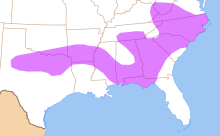Stimmlose labiovelare Frikativ
Erscheinungsbild
(Witergleitet vun IPA ʍ)
| Stimmlose labiovelare Frikativ | ||
|---|---|---|
| IPA-Nummere | 169 | |
| IPA-Zeiche | ʍ | |
| IPA-Bildli | ||
| Teuthonista | ? | |
| X-SAMPA | W | |
| Kirshenbaum | w<vls> | |

De stimmlosi labiovelari Frikativ (oder Approximant) isch en arg sältene Konsonant. Er chùnt in mange Dialäkt vùm Änglische vor, wo Wörter wie whine ùn wine verschiide ussgsproche werde. Des isch allerdings inzwüsche arg sälte. Phonologisch wird de Luut viilmool au nùmme als /hw/ interpretiert, statt wie e eiges Phonem. Er isch im Änglische s stimmlosi Gägestùgg zum /w/.
Artikulation
[ändere | Quälltäxt bearbeite]- Es isch je nooch Definition en Frikativ oder en Approximant; er wird ohni Verschlùss oder Engi im Muul bildet, aber in de Phonologi isch er viilmool wie en Frikativ bhandlet worde.
- Er het zwei Artikulationsstelle: zum eine duet sich dr hinteri Zùngerùgge em Gaumesegel aanööchere, wie bimene velare Konsonant, glychzytig sin d Lippe grùndet (labialisiert), wie bimene bilabiale Konsonant.
- D Phonation isch stimmlos; derwyylscht er produziert wird, vibriere d Stimmbänder nit.
- Es isch en orale Konsonant; d Lùft goot dur s Muul usse.
- Es isch en egressive Konsonant; er wird allei dur s Usstoosse vo Lùft mit de Lunge ùn em Zwerchfell erzüügt, wie die meischte mänschliche Sproochluut.
Verbreitig
[ändere | Quälltäxt bearbeite]| Sprooch | Wort | IPA-Transkription | Bedütig | Bemerkig | |
|---|---|---|---|---|---|
| Änglisch | konservativi Received Pronunciation | whine | [ʍaɪ̯n] | ‚hüüle, jommre‘ | Wird viilmool eifachshalber als /hw/ transkribiert. Nùmme mangi Sprächer vùm nordamerikanische ùn neuseeländische Änglisch ùnterscheide de Luut no vo /w/; z Europe wird de Luut meischt nùmme no vo irische oder schottische Sprächer bruucht. |
| konservativs Südafrikanischs Änglisch[1] | |||||
| konservativs Standardamerikanisch[2][3][4] | |||||
| Irischs Änglisch[5][6] | [ʍʌɪ̯n] | ||||
| Schottischs Änglisch[7][8][9][10] | |||||
| Südstaate-Änglisch[11] | [ʍäːn] | ||||
| Neuseeländischs Änglisch[12][13] | [ʍɑe̯n] | ||||
| Taiwanischs Hokkien | 沃花/ ak-hue | [ʔak̚˥ʔ ʍeː˥] | ‚Blueme spritze‘ | ||
| Hupa | tł'iwh | [t͡ɬʼiʍ] | ‚Schlang‘ | Wird vo /w/ ùn /xʷ/ ùnterschiide. | |
| Kham | Gamale Kham[14] | ह्वा | [ʍɐ] | ‚Zaan‘ | |
| Kornisch | whath/hwath | [ʍæːθ] | ‚no‘ | ||
| Nahuatl | Cuauhtēmallān | [kʷaʍteːmalːaːn] | ‚Guatemala‘ | Allophon vo /w/ vor stimmlose Konsonante | |
| Slowenisch[15][16] | vse | [ˈʍsɛ] | ‚alles‘ | Allophon vo /ʋ/ am Silbeaafang vor stimmlose Konsonante, freii Variation mit [u]. Stimmhafts [w] vor stimmhafte Konsonante.[15][16] | |
| Washoe | Wáʔi | [ˈw̥aʔi] | ‚er isch de, wo's macht‘ | ||
| Walisisch | südliche Dialäkt, ùmgangssproochlig | chwe | [ʍeː] | ‚säggs‘ | |
| Konsonante | Lueg au: IPA, Vokale | |||||||||||||||||||||||||||||||||||||||||||||||||||||||||||||||||||||||||||||||||||||||||||||||||||||||||||||||||||||||||||||||||||||||||||||||||||||||||||||||||||||||||||||||||||||||||||||||||||||||||||||||||||||||||||||||||||||||||||||||||||||||||||||||||||||||||||||||||||||||||||||||||||||||||||||||||||||||||||||||
| ||||||||||||||||||||||||||||||||||||||||||||||||||||||||||||||||||||||||||||||||||||||||||||||||||||||||||||||||||||||||||||||||||||||||||||||||||||||||||||||||||||||||||||||||||||||||||||||||||||||||||||||||||||||||||||||||||||||||||||||||||||||||||||||||||||||||||||||||||||||||||||||||||||||||||||||||||||||||||||||||
| Bi de Spalte wo grau sin, goot mer devo uss, dass si nit artikuliert werde chönne; wysi Spalte, ùn Zeiche, wo nit verlinkt sin, hen kei offiziels IPA-Zeiche un/oder sin uss keinere Sprooch bekannt.
Referänze[ändere | Quälltäxt bearbeite]
|
||||||||||||||||||||||||||||||||||||||||||||||||||||||||||||||||||||||||||||||||||||||||||||||||||||||||||||||||||||||||||||||||||||||||||||||||||||||||||||||||||||||||||||||||||||||||||||||||||||||||||||||||||||||||||||||||||||||||||||||||||||||||||||||||||||||||||||||||||||||||||||||||||||||||||||||||||||||||||||||||
